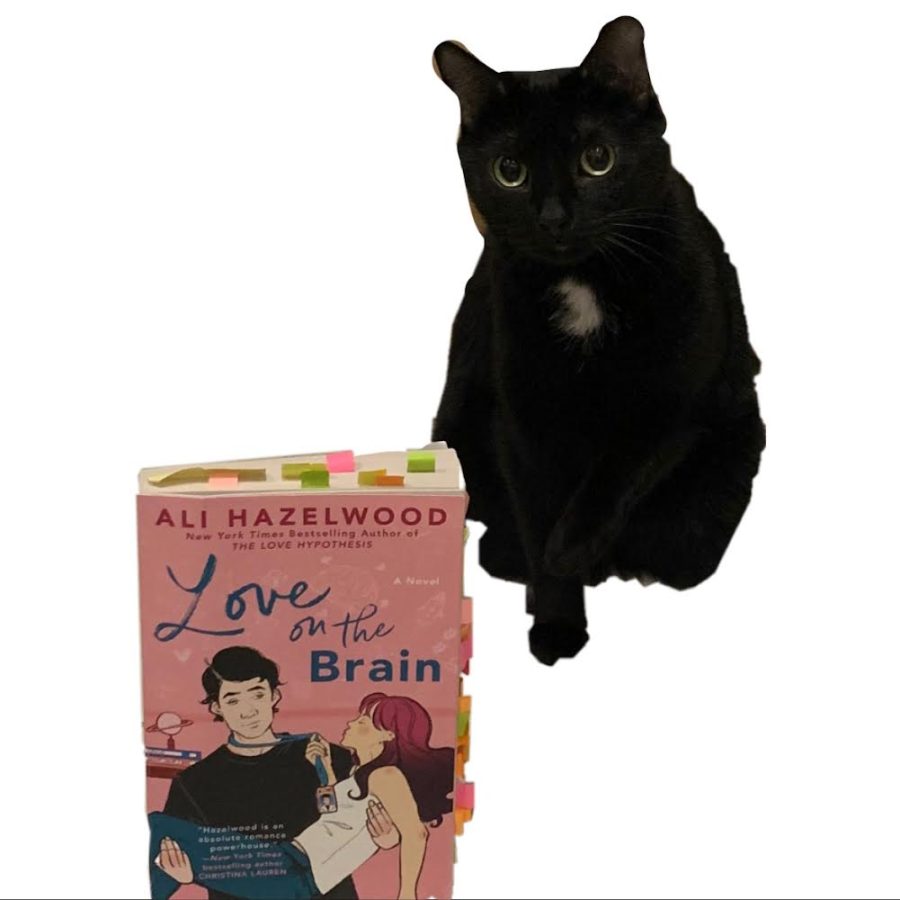Love On Your Brain- Book Review
Cat with Love on the Brain book.
December 5, 2022
Author Ali Hazelwood, accurately portrays the unfair treatment of women in the world of STEM in clear depictions of today’s society. She follows this theme in three of her earlier works – Under One Roof, Stuck with You, Below Zero, and The Love Hypothesis – and continues it in her most recent release, Love on the Brain, which takes place at NASA. Bee Königswasser, the protagonist, is a prime example of an independent woman trying to succeed in a world of toxic masculinity but still find romance.
The quirky, bubbly, cat-loving heroine goes through many bumps in the road on her journey to a successful future as a neuroscientist at NASA. She is constantly asking herself, what would renowned scientist Marie Curie do in her situation? This recurring internal struggle drives her day after day, leading to the moment when she narrates “The following day I got up, wondered how many other women in STEM felt alone as I did, and impulsively downloaded Twitter and made @WhatWouldMarieDo.” She created this account anonymously to spread awareness in the STEM community for women as well as a place to discuss the misogyny and unfairness that are ever present. Then Bee gets the chance of a lifetime to work her dream job as a neuroscientist co-lead at NASA. But the catch is that her co-lead on the project is none other than her graduate school nemesis, Levi Ward. Levi, meanwhile, is simply trying to achieve a successful prototype in this co-led project as well as prove to Bee that there has been a lot of miscommunication throughout their time at grad school
To set the stage, Bee is a woman trying to escape the clutches of her sexist boss by accepting the co-lead role at NASA for the project BLINK. Her main worry is whether she will be able to do her part in this project when she has to work alongside her grad-school nemesis. Multiple mishaps occur during her first few weeks, as well as a large amount of miscommunication between not only herself and Levi, but the entire program team. Secrets are uncovered, plans backfire, and falling in love just might be the third disaster on Bee’s list. “[… Despite popular belief, a saying is just a saying, and disasters do not come in threes. Except when they do.]” The book takes you on a rollercoaster ride of emotions, many of which will make a reader laugh, sigh with delight, or become frustrated. “-I know that Levi doesn’t like me, and Levi knows that I know he doesn’t like me and that I don’t like him in return. But he doesn’t bring it up, and I don’t really think about it. Because we have no reason to.” This highlights just one example of the many different types of frustration a reader can feel throughout Love on the Brain.
I experienced many of the same emotional upheavals as Bee while reading this book. I would often catch myself smiling down at the book as I too experienced the happy moments between not only the characters but also the progression of the plot throughout the book. There were times where I became hoarse with laughter, especially the banter back and forth between the characters. “Okay–I’m not proud of it, but it’s possible that my musical taste was influenced by the fact that in my formative years I, too, was an angry white boy.” Some of this hilarious banter would also have a deeper meaning at times, but still made me giggle to myself while my cats looked at me as if I were insane. “It is a truth universally acknowledged that a community of women trying to mind their own business must be in want of a random man’s opinion.”
Amusement was not the only strong emotion prompted during my reading. I often became frustrated, sometimes in response to the obliviousness of the characters, other times as the plot and characters took one metaphorical step forward then two steps back. Hazelwood does a stellar job at making the reader feel as though they too are in the story and feeling the same emotions as the characters.
Throughout Hazelwood’s writing, she proves time and again how much she truly understands the concepts of STEM discussed in Love on the Brain and her past books. New York Times bestselling author Christina Lauren furthers this: “Hazelwood is an absolute romance powerhouse.” Not only does Hazelwood have firsthand experience of being a woman in STEM, she also has a Ph.D. in neuroscience and has recently became a professor. Hazelwood’s personal knowledge brings new life to the story. “Hazelwood proves that she is the perfect writer to show that science is sexy as hell,” compliments #1 New York Times bestselling author Jodi Picoult. Because of her experience, Hazelwood is able to apply more comprehensive detail about complex topics discussed in Love on the Brain that give a stronger understanding of the material to the reader.
The intent of Love on the Brain is not only one that can be applied to our society but can also be a lesson that shows young women everywhere that they are not alone in their endeavors through the world of STEM. The themes that are brought up throughout this book are given the detail and time they deserve and expressed in such a passionate way. Hazelwood makes readers feel heard as she addresses issues such as the misogyny in STEM, social media awareness, and miscommunications. After reading this book I have a much better understanding of what it must be like for women who work in STEM, and have to work twice as hard in order to prove their worth in the world of science. When reading this not only did I feel the passion Hazelwood has for her characters but the storyline as well. All in all, Hazelwood did a splendid job with Love on the Brain and the concepts brought up right through the book’s conclusion. I can’t wait to read her future stories.


